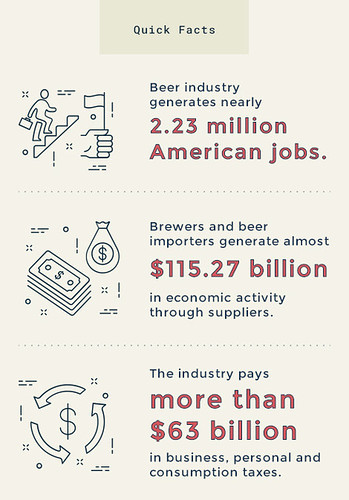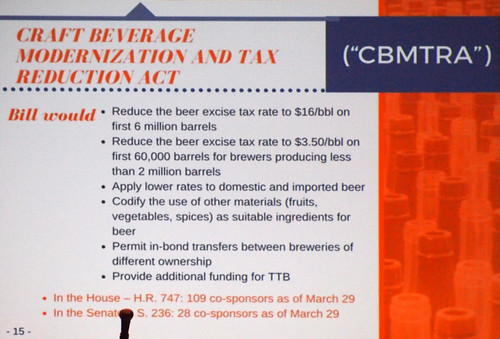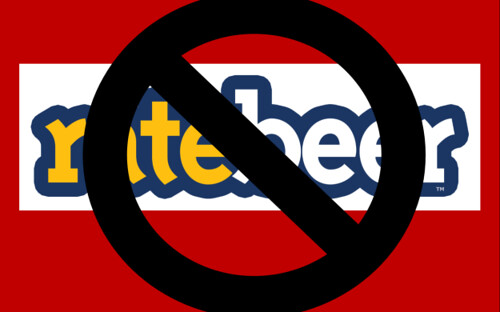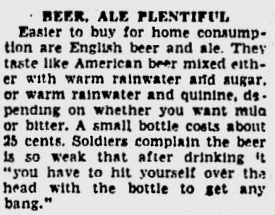
An occasional collection of
short stories on beer and other things,
originally posted to YFGF's companion Facebook page
but not posted here at the blog (that is, until just now).
******************
“What’s happening to US IPA? Has it turned into a sort of fruit punch?”
That was British beer historian Ron Pattinson, recently in Atlanta, Georgia, musing as he sipped (gulped?), there, a pint (!) of Transmigration of Souls, a 10% alcohol-by-volume IPA, brewed by local brewery, Orpheus Brewing.
******************
Some American breweries no longer welcome as sponsors of Great AMERICAN Beer Festival.
At this year's Great American Beer Festival, for the first time, breweries who don’t fit the definition of 'craft brewery' as determined by the Brewers Association will no longer be allowed to purchase sponsorships. Sponsors receive perks such as larger exhibition booths with more prominent placement. "Effective immediately and in support of the BA’s mission and purpose, only breweries that meet the BA craft brewer definition are eligible to be a Featured Brewery sponsor at GABF," according to the BA.To put things in perspective, last year, the GABF had eight sponsors that will not be eligible this year: 10 Barrel and Breckenridge, which are owned by Anheuser-Busch InBev; Blue Moon and Leinenkugel, which are produced by MillerCoors; Ballast Point, which is owned by Constellation Brands; Lagunitas, which was recently acquired entirely by Heineken; Magic Hat, which is a part of the North American Breweries conglomerate; and Pabst.
- Original story at Food and Wine (9 June 2017).
- The [U.S.] Brewers Association does not define 'craft' beer. It does, however, define 'craft' brewery, principally as a measure of annual production.
******************
Beer works
The U.S. beer industry provides jobs to nearly 2.23 million Americans, contributes over $350 billion to America’s economy, and pays $63.5 billion in annual taxes.
- Brewers and importers directly employ 64,745 Americans.
- Suppliers to the brewing industry employ more than 491,800 Americans.
- Beer wholesalers directly employ more than 134,240 Americans.
- Beer retailers employ 915,700 Americans.
Related...
******************
A CBMTRA thought experiment.
On 30 January 2017, Senate Bill S.236 —aka the Craft Beverage Modernization and Tax Reduction Act — was (re) introduced in the U.S. Senate by Ron Wyden, a Democratic senator from Oregon. The bill now sits with the Senate's Committee on Finance for consideration.
- Under current law —the Internal Revenue Code of 1986 (!)— a small brewery that produces fewer than 2 million barrels of beer per year pays $7.00 U.S. excise tax per barrel on the first 60,000 barrels it produces. The CBMTRA would reduce that rate to $3.50 per barrel.
- Once production exceeds 60,000 barrels, the rate is currently $18 per barrel excise tax rate, an industry-wide rate, large or small. The CBMTRA would reduce that rate to $16 per barrel (up to 6 million barrels of annual production).
- Among additional provisions, the CBMTRA would also expand the list of ingredients that could be automatically included in a beer without prior approval (not including cocoa puffs and dingleberries), and allow breweries to transfer beer between themselves without any additional taxes (think collaboration beers or, in some cases, contract brews).
In the House, Rep. Erik Paulsen [R-MN-3] re-introduced its version of CBMTRA on 30 January. The bill now sits with the House Ways and Means Committee for consideration. In March, there were 109 House co-sponsors of CBMTRA. Now, there are 191, also a bi-partisan spread.
The [U.S.] Brewers Association insists that the excise tax cut of CBMTRA is needed to spur the growth of the 'craft' brewery industry. But...
Concurrently, the BA trumpets the robust growth of its members to a 5,300 historical high count of breweries. Growth which has occurred without a tax cut. Thus, hasn't growth been robust, nay, 'revolutionary,' without? Considering inflation, wouldn't maintaining the beer excise tax rate —$7 for the first 60,000 barrels of beer a brewery produced— which Congress legislated in 1976, be the virtual equivalent of a significant rate cut in 2017, in fact, almost half the 1976 rate?
******************
Something fishy with RateBeer
Like a bad-news chyron, Anheuser-Busch InBev's purchases of 'craft' breweries and other 'craft' things continue unabated. Blink and you might miss the next one. Unannounced in October 2016, Anheuser-Busch InBev —via its wholly owned ZX Ventures, a "global disruptive growth" investment company— purchased a minority stake in RateBeer —a highly regarded web-based crowd-powered beer-rating service.
RateBeer was founded in 2000 and purchased in 2001 by Joe Tucker, a web-site consultant. As of 2013 (according to Wikipedia), RateBeer had amassed 4.5 million ratings of 200,000 beers, from 16,000 breweries, worldwide.
Official word of that purchase came only on 3 June 2017, and then seemingly only because of the investigative journalism scoop of website Good Beer Hunting.
Tucker's reasons for selling, which he posted to RateBeer, comprised the typical happy-talk that seems cut-and-pasted from all such similar craft-to-corporate sales.
What we’ve found on the other side is a multicultural company that cares deeply about their own employees, cares about the local communities they invest in developing and is taking significant steps to better understand and foster local beer. It’s a great small team in a big company. ZX Ventures has the utmost respect for the integrity of the data and the unbiased service we offer to the entire community and industry. [...] Life at RateBeer will continue as it has. I’ll continue to work writing code, crunching numbers, answering questions, working with our administrators, reaching out to talk to people in the community and planning new features.
The granddaddy of crowd-sourced web beer raters, Beer Advocate (founded in 1996), remains independent. Newer beer rating service Untappd (more a mobile phone service than desktop) was purchased in whole in 2016 by Next Glass, a beer-and-wine rating application. Since its founding, RateBeer has been a trove —through its voluminous and real-time data— of insights and analysis into trends in 'craft' beer.
Caesar's wife must be above suspicion. RateBeer, no wife of Caesar, just fell into a world of doubt. A world that most 'craft' beer drinkers will refuse to enter. Despite its protestations of non-interference, ZX's influence over RateBeer will be a consideration in the minds of 'craft' beer drinkers. Are those scores created by ABIB bots or by ZX (thrice-removed) paid-off bloggers? And then this happened, as reported by Paste Magazine on 14 June:
In Sept. of 2016, RateBeer introduced a feature called “Brewer Rating,” which appears on every brewery’s profile page. The number is meant to be an at-a-glance indicator of how well that brewery’s full lineup of beers has rated; the purest and most simple condensation of which breweries are “good” and “bad” for an average user who isn’t going to deep-dive among the entire lineup of brews. When the system was introduced, and at least into Oct. of 2016, the Brewer Rating of Anheuser Busch-InBev stood at 74/100. Not exactly rosy.
Today, that number stands at 90/100. In the interim, only a superficially small number of new ratings have been added to the brewery—1.3% more reviews, to be precise—which is not nearly enough to reasonably expect them to influence the score from 74 to 90. It at first appears to be a significant 21.6% increase in the overall Brewer Rating, but because the actual range of the scale is 50-100 rather than 1-100 (for reasons we’ll explain shortly), 50 being the lowest possible score a brewery can have, the relative percentage of increase in Brewer Rating is even higher. Taking into consideration that this is actually a 50-100 scale, it’s as if the score changed from 24/50 to 40/50, which is a 66.7% increase since October—which is of course also when AB-InBev happened to invest in RateBeer
Moving forward, RateBeer's impartiality will be in doubt. As writer Steve Body —never one to mince words on his loathing of anything Anheuser-Busch — put it, at his blog, The Pour Fool:
You have just struck a deal with the Devil and NO amount of slick explanation is going to invalidate or blunt the simple FACT that you are now beholden to the very company that is making the most concerted effort – in fact, pretty much the ONLY concerted effort – to hamstring or destroy altogether this culture that has spawned your own personal success, that of the 5000 small, independent breweries that make up the Indie/Craft community, and the happiness and enjoyment we all have lived out for the past 25 years, in watching our beer horizons open wide and carry us up and out of the century+ morass of sameness and forced homogeneity of beer. [...] So, here it is. DEAD. RIP RateBeer, long loved and QUICKLY compromised.
******************
Schadenfreude, not success?
News of YFGF's former bailiwick:A newly released economic impact study shows that Virginia’s booming beer industry contributes more than $9.34 billion annually to Virginia’s economy. [...] Virginia’s Department of Alcohol and Beverage Control (ABC) has reported 206 active brewery licenses in the Commonwealth, a 468% growth since 2012, when the tasting room bill, SB604, passed the General Assembly. A recent economic impact report by the Beer Institute showed that the Virginia beer industry employed over 28,000 people in production, distribution, and retail, and contributed nearly a billion dollars in state and local taxes in 2016. Excise and sales taxes on beer consumption contributed another $280 million to Virginia’s tax rolls last year.
—This comes from Virginia Craft Beer Magazine online, which weirdly decided to put the emphasis not on the state's success but on that it now comprises more breweries than neighboring state North Carolina. The magazine titled its story, "Virginia surpasses NC with 206 Breweries," reporting that "the North Carolina ABC reports 186 active brewery licenses."
- The piece pictured Virginia's governor, Terry McAuliffe (in white patterned shirt, NOT holding a beer), during whose administration beginning in January 2014, the story notes, "the number of breweries in the Commonwealth has more than doubled." Not identified are the three people the Governor is standing with and not mentioned is where they are or why (a news story no-no).
- As an additional reference point: when YFGF moved from Virginia in November 2015, the Virginia ABC listed 127 active brewery license holders.
******************
Like mixing your beer with rainwater and sugar.
A fortnight before the D-Day invasion of Nazi-occupied Normandy, France— the Fredericksburg (Virginia) Free-Lance Star published a story by American war correspondent Hal Boyle, one of many for Boyle, who would later win the Pulitzer Prize for his wartime dispatches.
Boyle's reporting, on 25 JMay 1944, described the condition of booze in wartime London, England. Gary Gillman, at his blog "Beer et. Seq.", summarized the account. His post —"Blondes, Taxis, and the West End"— includes Boyle's description of what he and the American GIs thought of British milds and bitters.
Seeking to explain mild ale and bitter beer to Americans, Boyle said mild is like mixing your beer with rainwater and sugar. And bitter is like mixing it with rainwater and quinine. (Today he might say that currently faddy 'juicy' IPA is like mixing Bud with vodka and grapefruit juice).
Given that American lager in this period was still fairly bitter, it shows that English beer – pale or bitter ale – easily outstripped it. Since no unusual bitterness was detected in mild ale, one can assume its bitterness was about equal to mid-century American lager.
The weakness of British beer was remarked on, something I’ve discussed before as noticed by an Australian journalist. He stated the government must have pondered long and hard to get the stimulant/austerity balance exactly right. [And Boyle noted that] The American soldier’s reaction was typically popular and idiomatic: it’s like our beer if you drink it and get hit in the head with the bottle.
-----more-----
- Sunday Facebook Check-out is an occasional wrap-up of a few posts at YFGF's companion Facebook page.
- YFGF does have a more regular, if selective, recap of "news of beer and other things." Clamps and Gaskets is published bi-weekly.
- For more from YFGF:
- Follow on Twitter: @Cizauskas.
- Like on Facebook: YoursForGoodFermentables.
- Follow on Flickr: Cizauskas.
- Follow on Instagram: @tcizauskas.















No comments:
Post a Comment
Comment here ...